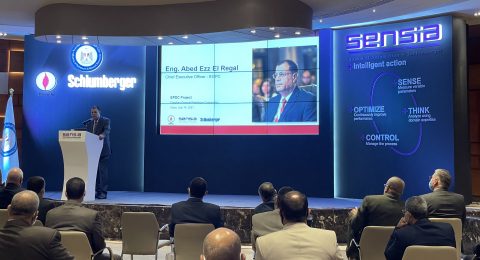The 1970s was a period of transition for the Egyptian petroleum sector. The Petroleum Policy of 1973 mandated production-sharing contracts, which along with increased oil prices, attracted foreign investors. Exploration agreements for concessions in the Western Desert and Nile Delta regions were signed, yet exploratory activity during this time yielded few results.
Throughout the 1980s and most of the 1990s, liquid production steadily increased. The discovery of the Western Dessert’s Badr El Din and Abu Sennan fields by Shell and GPC dramatically increased the country’s reserves. High oil prices created a favorable production climate, yet even when prices decreased in the early 1990s, Egypt was able to maintain production through strong activity in the Western Dessert and production peaked in 1993 with 912,000 bbl/d. Attention began to shift away from the now maturing Gulf of Suez region and turned towards the Western Desert and Mediterranean regions. By the end of the millennium, oil production rates were at 729,900 bbl/d and much of the country’s suspected oil acreage had been licensed out.
In the early 2000s, licensing diminished and the lengthy process of contract approval began to affect production rates. In 2003, the Ministry of Petroleum overhauled the licensing process with the Egyptian Natural Gas Holding Company (EGAS) and Ganoub El Wadi Petroleum Company (GANOPE) taking control of licensing acreage in the gaseous regions of the Nile Delta and Mediterranean (EGAS), as well as Upper Egypt and the Red Sea (GANOPE), while EGPC retained licensing rights over the Gulf of Suez and the Western Dessert. The last decade of oil production can be characterized by secondary recovery techniques in the mature Gulf of Suez fields, the establishment of the Western Dessert as a key producing region in temporarily reversing production decline, and the licensing in Upper Egypt as an attempt to increase reserves. The Belayim fields and the Gupco Merged Concession Area remain at the forefront of oil production in Egypt.

Reserves
Egypt is estimated to hold 12,446 mmbbl initial recoverable liquid reserves. After decades of production, it is estimated that the country has approximately 1,888.9 mmbbl recoverable oil remaining, as of January 2011.
These figures indicate that 83% of Egypt’s recoverable oil reserves have been depleted. If Egypt is to remain an oil producing nation in the long-term, it will be necessary to significantly increase reserves. The Western Desert has potential for increased reserves, yet the leading operator in the area, Apache, has shifted their strategy towards natural gas production as Egypt’s dependency on gas has grown rapidly. Without increased crude oil reserves, Egypt’s oil production will begin a period of decline within the coming decade. See chapter two for information regarding Egypt’s natural gas reserves and production levels.
Egypt is estimated to hold 402.6 mmbbl initial recoverable condensate reserves. Since these reserves are largely found in the Nile Delta/Mediterranean region’s natural gas prone structures, which have only come into play in the last 20 years are not as depleted as the country’s crude oil reserves.
With an estimated 402.6 mmbbl recoverable condensate reserves remaining as of January 2011, Egypt’s condensate reserves are 54% depleted. Condensate reserves have great potential for growth as they are mostly found in the Nile Delta/Mediterranean and Western Desert areas, where gas potential is actively explored.
Egypt is estimated to have just over 100 mmbbl initial recoverable LPG reserves, over half of which are remaining reserves since more than 90% of these reserves are found in the Nile Delta/Mediterranean region. These reserves are likely to grow in the coming years. Rate of production is also expected to increase as processing facilities in the area expand.
Prior to the 1960s, liquid production in Egypt was limited to a handful of fields from Sinai and the Gulf of Suez, led by Gemsa and Ras Gharib. The development of Belayim fields brought Egypt’s oil production to rates exceeding 100,000 bbl/d.

Production data is not available between 1967 and 1975 due to the Israeli occupation of Sinai. However, as shown in the graph above, production did increase from 1967 to 1970 as a result of Morgan field being brought onstream. Production from July and Ramadan fields further increased production levels in 1977. Production rate continued to increase to mid 1980s, until the low oil prices negatively impacted production levels.
Following the 1993 peak in liquid production, Gulf of Suez production began to decline significantly. The area still produces liquids at substantially higher rates compared to other areas in Egypt with the Gupco concession leading production, and secondary recovery techniques have helped to mitigate production decline.
Since the late 1990’s, liquid production from the Western Desert has been in the rise. The area emerged as an extremely important region for Egypt as it has largely offset oil decline from the Gulf of Suez. The Western Desert will remain a significant area for both liquid and gas production over the coming decade.

Renegotiations of fiscal terms on several concessions including BPs Gupco Merged Concession Area and Eni’s Belayim fields in the last decade, along with new investments in the Gulf of Suez, have slowed the area’s production decline. Combined with the Western Desert production and the NGL and condensate production in the Mediterranean/Nile Delta, liquid production in Egypt has witnessed an upward trend since 2007. This trend is expected to reverse again by 2012 and liquid production will continue to decline unless further significant oil discoveries are made. However, with the country’s increasing natural gas demand, investors are now focusing on increasing reserves and producing gas.
By Jermeen El-Baroudy







